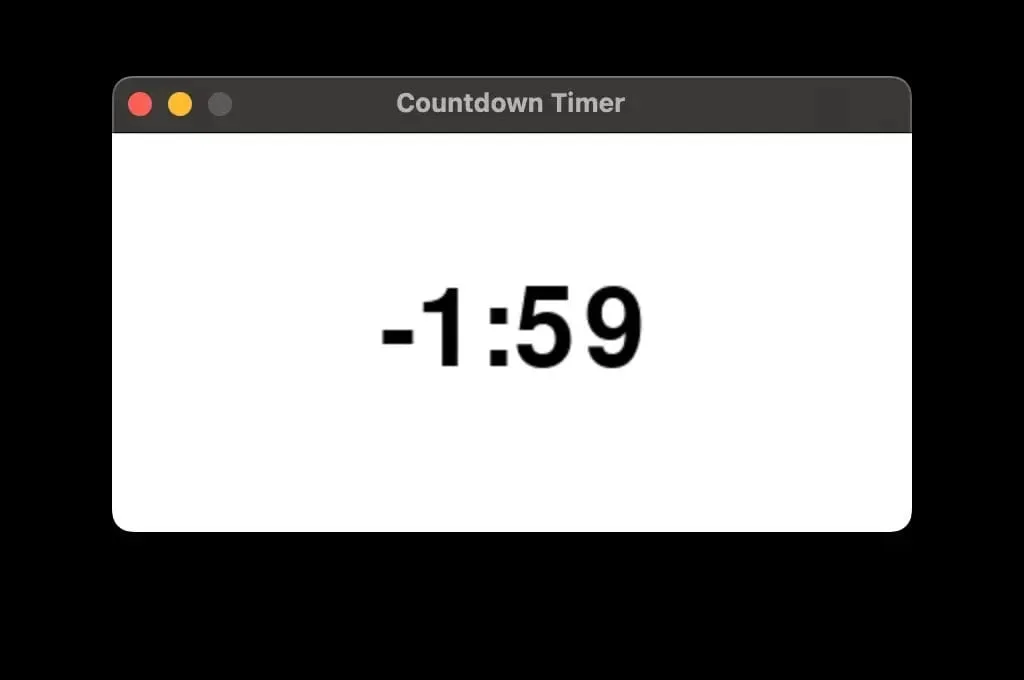🐍🚀 how to use ChatGPT for Python code
This is a past issue of the mathspp insider 🐍🚀 newsletter. Subscribe to the mathspp insider 🐍🚀 to get weekly Python deep dives like this one on your inbox!
The countdown timer
The other day I was giving a Polars training and I needed a countdown timer so people knew how long they had to solve the exercises.
I asked ChatGPT for a Python + pygame script that showed a countdown timer and I got something quite decent:

I skimmed through the code and it looked good, so I was quite happy about it.
Until I wasn't.
The countdown went down to 00:02, 00:01, 00:00...
And then it jumped to -1:59, where it stopped:

Which means I had to go and dig for the bug.
ChatGPT gets me 80% there...
But the remaining 20% are annoying as hell.
So far, this has been my experience with ChatGPT and other LLMs.
When I ask them for code, I get code that looks good but that sooner or later blows up in my face.
(One time, I asked for a standard implementation of a standard graph algorithm: depth-first search.
There are thousands of these online.
ChatGPT produced one that had a nasty mutability bug that took me a while to debug...)
This time, it was the way ChatGPT was doing computations with the time.
Like, the operations made no sense.
If it's 18:11:23 and I set a timer for 3 minutes, the timer should be up at 18:14:23, that's it.
At each point, check how many seconds are left until 18:14:23 and present the numbers based on that!
Instead, ChatGPT was doing some silly computations at each frame.
What I tend to see is that the bugs are particularly infuriating because they're a type of bug I would “never” do.
(Probably, I would. I just like to think I wouldn't.)
After the initial prompt, a few follow-up prompts, and some manual fixing and tweaking, I concluded that it was great to have ChatGPT produce most of the boilerplate for the timer and to get something that almost worked.
Then, I had to fix a couple of bugs by prompting a bit more and in the end it was easier to just add a bit of extra functionality by hand.
Given this experience, that I've had repeatedly, I think I figured out my best use case for ChatGPT: quickly prototyping boilerplate.
And then I implement the features myself.
For example,
- I've used ChatGPT to produce the boilerplate for a CLI app that uses Click and it set up the structure of the commands and arguments, but then I implement the argument functionality myself.
- I've used ChatGPT to produce the boilerplate of this pygame program for the countdown timer but then I added some features myself.
- I've used ChatGPT to produce the boilerplate for a pandoc filter (something I use when publishing my books) but then I implemented the algorithm inside the filter myself.
Is this similar to your experience with ChatGPT and other LLMs?
How do you use them?
uv wizardry
In the end of the countdown timer adventure, I took the countdown timer and I put the code online.
I wrote a short blog post telling this ChatGPT story in more detail and I “attached” the code for the timer to that article in this URL: https://mathspp.com/blog/using-an-llm-to-write-a-countdown-timer/cd.py.
If you click the link, it should open the source code.
If you look closely, here is what the first few lines of the script look like:
#!/usr/bin/env -S uv run
# /// script
# requires-python = ">=3.13"
# dependencies = [
# "pygame",
# ]
# ///The very first line is a shebang that lets me use the script as an executable that runs through uv, and the following lines (from /// script to ///) are a header that uv added to the file.
What does that header do?
It tells uv the Python version that the script runs on and its dependencies, so that the script is a standalone script.
If the code of the script is in the file timer.py, then running uv run timer.py will tell uv to run your script, and because of the header it will install pygame in an isolated environment in order to run your code.
Additionally, if you give it executable permissions (with chmod +x timer.py, for example), you can just run ./timer.py.
For the timer, specifically, you need to specify the number of minutes as an extra argument, so you'd do uv run timer.py 3 or ./timer.py 3 with executable permissions.
uv is SO cool, that if you have it installed, you can even run my timer directly from the internet, with
uv run https://mathspp.com/blog/using-an-llm-to-write-a-countdown-timer/cd.py 3Learn more about this usage of uv in this article: https://mathspp.com/blog/til/standalone-executable-python-scripts-with-uv
Enjoyed reading?
This is a past issue of the mathspp insider 🐍🚀 newsletter. Subscribe to the mathspp insider 🐍🚀 to get weekly Python deep dives like this one on your inbox:
